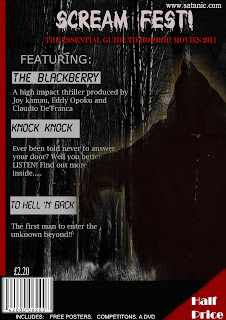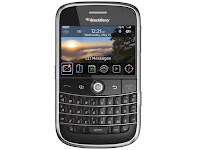The complete evaluation of my advanced portfolio can be found on my prezi:
Prezi Evaluation: http://prezi.com/o_64uqnpxmh5/edmund-opokus-a2-media-advanced-portfolio-evaluation/
A2 Media Edmund Opoku Candidate number - 2195
About Me
Thursday, 31 March 2011
All three final products
Below is the completion of all three products. These being, Our film trailer "The Blackberry", My film poster and Front Magazine Cover.
Tuesday, 11 January 2011
Audience Theory
In todays media lesson, we looked at "Audience theory" in relation to our final production work.
These are theories that explain how we take in the media all around us and the effects it has on us
It assumes that the audience just sits there and gets injected with non-stop information.
This suggests that the audience does not absorb information directly from the text but is influenced by opinion leaders. Social factors are also seen to be improtant in the reception of media texts.
Uses and Gratification
Stuart Hall- Talk about the encoding/decoding model of relationship between audience and text.
The text is encoded by the producer (meaning inscribed). It is then decoded by the reader (in ways that the producer cannot control).
Niche Marketing
Despite the tendancy to try to reach a large audience for the media text, it is important that we dont forget to look at "narrow casting". It is the oppsite of " Broadcasting"
Audiences
Julian McDougall(2009)- suggests that in the online age, it is getting harder to conceive a media audience as a stable identificable group. However, audiences still clearly makes sense and give meaning to cultural products.
An audience can be described as a "temporary collective" (McQuail 1972)
Leng Ang (1991)
"Audiences only exist as an imaginary entity" - so in other words, we create an imaginaryimage of our targetted audience before we create our product.
Hartley (1987)
Also suggests that institutions must produce "invisisble fictions of audience which allow the institutions to get a sense of who they must enter into relations with"
- We need to look at the ways the audience receives, reads and responds to any media text. This is important for construction and distribution of our productions as well as for collective identity.
- We also look at how to distribute texts in order to attract or reach our target audience. (Advertising package)
These are theories that explain how we take in the media all around us and the effects it has on us
- How the media might influence (or not influence) our behaviour.
- Some theories lead us to think we need more censorship of the media, whilst others might lead us to call for less control.
- Theory helps us to work out the complexity of relationships between audience and texts.
It assumes that the audience just sits there and gets injected with non-stop information.
- Audiences are seen as passive recievers of information transmitted in the text without thinking about them or challenging them.
- People began to see the power of the media to influence and communicate messages - production of propaganda to influence thinkng.
This suggests that the audience does not absorb information directly from the text but is influenced by opinion leaders. Social factors are also seen to be improtant in the reception of media texts.
Uses and Gratification
- Audiences were seen as being made of individuals who were active consumers. Mass is that they did the same thing but in different ways.
- This theory was developed further in in 1974 by Blumer and Kutz
- Diversion-(escape from everyday problems and routines)
- Personal relationship-(Using the media for emotional or other interaction)
- Personal Identity-(Finding yourself reflected in texts, learning behaviour and values for texts)
- Surveillance- ( Finding information which could be useful for living) such as: weather, financial news, holiday information etc.
Stuart Hall- Talk about the encoding/decoding model of relationship between audience and text.
The text is encoded by the producer (meaning inscribed). It is then decoded by the reader (in ways that the producer cannot control).
Niche Marketing
Despite the tendancy to try to reach a large audience for the media text, it is important that we dont forget to look at "narrow casting". It is the oppsite of " Broadcasting"
Audiences
Julian McDougall(2009)- suggests that in the online age, it is getting harder to conceive a media audience as a stable identificable group. However, audiences still clearly makes sense and give meaning to cultural products.
An audience can be described as a "temporary collective" (McQuail 1972)
Leng Ang (1991)
"Audiences only exist as an imaginary entity" - so in other words, we create an imaginaryimage of our targetted audience before we create our product.
Hartley (1987)
Also suggests that institutions must produce "invisisble fictions of audience which allow the institutions to get a sense of who they must enter into relations with"
Wednesday, 15 December 2010
My final film poster
This is my final film trailer poster " The BLACKBERRY"
Researching on horror film posters gave me the idea of using dark colour schemes. In this case I chose to go with a simple black, red and white colour scheme. I also used this same colour scheme in the making of my magazine cover. This also helped reveal the genre of the film being advertised and helped with the mise-en-scene. Including the quote at the top of the poster, helped to give a hint to the audience of what to expect as well as get them a little bit scared. All this helps to set the atmospheere for the film. I purposely surrounded the text in a red rectangular shape to help it stand out. The inclusion of the age certificate made the audience aware of who were legally permitted to view the film. To help determine the title of the film being advertised, I ensured that the title was in an obvious big red font. Doing this helped to attract attention and make it visable amongst all the other texts. As most of the scenes in our film trailer were set in the woods, I tried to incorporate this setting in both my film poster and magazine cover. Doing this helped to keep the same house style and mise-en-scene. To keep the horror/thriller genre, I included haunting eyes in the background and the scared expression on my actors face. To help emphasise on the title of the poster, I made my actor hold a "blackberry" in both hands. I finally finished my film poster by adding credits which included the names of the producers and directors of the film. To keep my audience in the dark, I did not reveal the release date of the film and instead wrote "COMING SOON".
Researching on horror film posters gave me the idea of using dark colour schemes. In this case I chose to go with a simple black, red and white colour scheme. I also used this same colour scheme in the making of my magazine cover. This also helped reveal the genre of the film being advertised and helped with the mise-en-scene. Including the quote at the top of the poster, helped to give a hint to the audience of what to expect as well as get them a little bit scared. All this helps to set the atmospheere for the film. I purposely surrounded the text in a red rectangular shape to help it stand out. The inclusion of the age certificate made the audience aware of who were legally permitted to view the film. To help determine the title of the film being advertised, I ensured that the title was in an obvious big red font. Doing this helped to attract attention and make it visable amongst all the other texts. As most of the scenes in our film trailer were set in the woods, I tried to incorporate this setting in both my film poster and magazine cover. Doing this helped to keep the same house style and mise-en-scene. To keep the horror/thriller genre, I included haunting eyes in the background and the scared expression on my actors face. To help emphasise on the title of the poster, I made my actor hold a "blackberry" in both hands. I finally finished my film poster by adding credits which included the names of the producers and directors of the film. To keep my audience in the dark, I did not reveal the release date of the film and instead wrote "COMING SOON".
Tuesday, 14 December 2010
Stages for my film poster (drafts)
These are the stages I went through to complete my film poster. As you can see through the pictures, I have changed and improved some aspects of my poster.
Monday, 13 December 2010
Poster sketch/plan
Below is a hand drawn sketch/plan of what my poster might look like. I might not necessarily follow my original idea but it is still a starting point for my production.
Subscribe to:
Posts (Atom)














